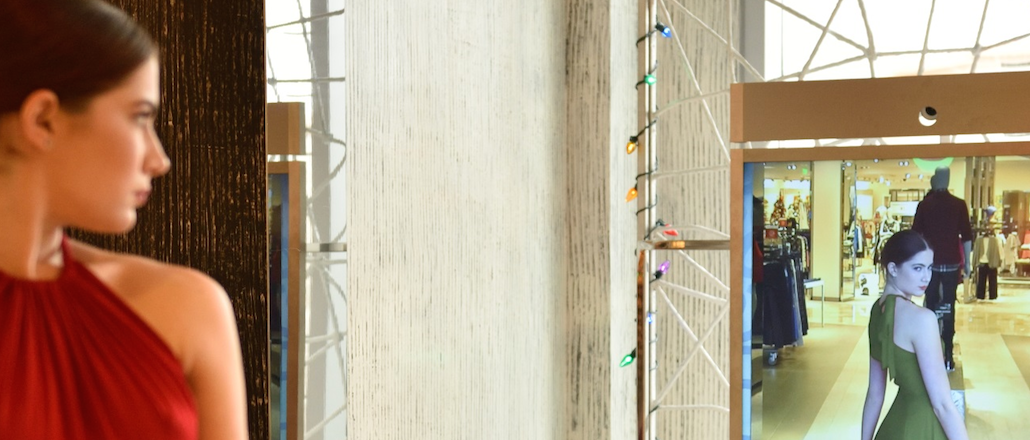
As traditional retailers digitize physical stores, one of the final frontiers is the fitting room. Companies have been reluctant to intrude with technology where customers strip down.
But that doesn’t mean the fitting room as we know it — just a sectioned off stall with a mirror — isn’t primed to evolve. Allen & Gerritsen research found that in 2014, customers were 71 percent more likely to buy after they’ve tried something on, and 90 percent of retail transactions continue to take place in stores.
What happens behind the fitting-room curtain clearly has an impact on sales, and as physical stores adapt digitally, the dressing room will join — once customers get used to it.
“Eventually we’ll get to a point where the next generation cares even less about privacy,” said Chris Reif, svp of creative and innovation at Allen & Gerritsen, and co-founder of A&G Labs, an in-house innovation unit. “Brands are being more transparent about where their data is going, so we’ll get more comfortable.”
We’re not there yet. Tugging on a pair of jeans is a vulnerable experience, and not one where more modest customers want to see a login screen and a smart mirror. As a result of such privacy concerns, two sectors of fitting-room technologies have formed: those that come into the room with customers, and those that stay outside.
At certain Neiman Marcus locations, customers can now test MemoryMirror, once they’ve stepped back onto the main sales floor. The smart mirrors, which come from California-based company MemoMi, record an eight-second video and take stills as shoppers stand in front of them. Once the imagery is recorded, the mirror’s technology can swap in different colors and patterns, add accessories, compare side-by-side photos and video with another outfits, and send the images and video to the shopper so she can continue the virtual fitting experience at home with Neiman Marcus’s online inventory.

Ad position: web_incontent_pos1
“The goal is to continue to introduce technology into our stores in order to enhance the customer experience,” said Mimi Sterling, vp of communications at Neiman Marcus. “It’s a purely user experience — it was never about the data.”
The only data gained from customers who use the MemoryMirrors is their gender and age range, which is necessary to log in to the system, according to MemoMi founder and CEO Salvador Nissi Vilcovsky, who added that no measurements or product tracking are taken through the mirrors. Still, customers’ inclination to be wary of a “smart” mirror is strong enough that the mirrors sit firmly outside of the fitting rooms.
“People get nervous about data. It has that ‘Big Brother’ effect,” said Reif. “But it’s an education thing — there was a time when people weren’t comfortable even shopping online.”
To avoid scaring off the wary, A&G Lab’s fitting room technology experience “MVSE” (pronounced Muse) foregoes the virtual fitting. MVSE is a wall tablet installment that provides product information as customers are mulling over a potential purchase. Powered through a retailer’s app, MVSE requires users to scan a barcode on their phones to start up the experience. Then, they can see product reviews, purchase history, suggested items and the store’s trending looks — just like they would when shopping online.
“We wanted to take what people love about online shopping and bring that into the fitting room. Instead of sitting there with blank walls, you can see what pants or necklace would look good with a top, for instance,” said Reif.
Ad position: web_incontent_pos2
The MVSE team is still working to get the product into retail stores. Reif said that many traditional retailers have yet to update their fitting rooms because of the logistical bandwidth needed (adopting the technology, which has to be powered by the store’s e-commerce site, and training store employees are just two obstacles) and the if-it’s-not-broke-don’t-fix-it mentality some traditional companies hold.
“Retailers see fitting rooms as a personal thing, and can be reticent to put technology in there,” said Reif. “There’s a behavioral change that comes with it, but we’ll get there.”
Images via MemoMi Labs
More in Marketing

In the marketing world, anime is following in the footsteps of gaming
As marketers look to take advantage of anime’s entry into the zeitgeist, they might be wise to observe the parallels between the evolution of anime as a marketing channel and the ways brands have learned to better leverage gaming in recent years.

With the introduction of video ads and e-commerce, Roblox looks to attain platform status
Roblox is expanding into more areas than just ads in 2024. Much like platforms such as Amazon and Facebook have transcended their origins to evolve from their origins as online marketplaces and social media channels, Roblox is in the midst of a transformation into a platform for all elements of users’ virtual lives.

PepsiCo wants to remain a ‘driver of culture’ as it turns to influencers and activations amid rebrand
The soda-maker says it can translate cultural relevance into sales volume.
Ad position: web_bfu